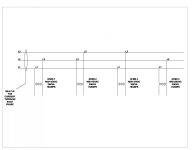I have a 460VAC 3 phase system that I want to add 4 transformers to, Each transformer is 35KVA(76A@460V). I know in 2 of the three phases the current should be higher than the 3rd but I am not sure how to calculate it. I know if I had 3 transformers the current should be 131A(76A*SQRT3)through each leg.
I believe L3 would remain at 131A but L1 and L2 would change.
Any input is appreciated.

I believe L3 would remain at 131A but L1 and L2 would change.
Any input is appreciated.







